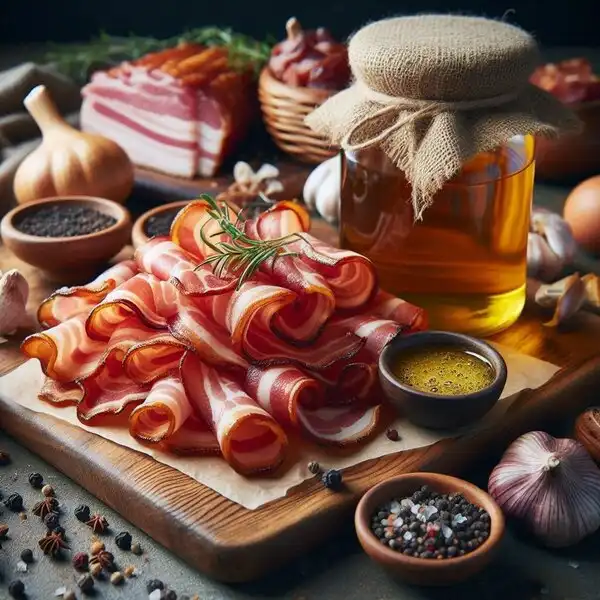How to Cure Bacon: A Comprehensive Guide
As a bacon enthusiast, I've always been fascinated by the process of curing bacon. The perfect balance of salty, sweet, and smoky flavors is a culinary delight that's hard to resist. But have you ever wondered what makes cured bacon possible? The answer lies in the use of nitrites, a crucial component in the curing process. In this section, we'll delve into the world of nitrites, exploring their role in meat preservation, benefits, and drawbacks.

What are Nitrites and Their Importance in Meat Preservation?
Nitrites are a type of preservative commonly used in cured meats like bacon, ham, and sausages. They're responsible for inhibiting the growth of bacteria, particularly Clostridium botulinum, which can cause botulism. Nitrites achieve this by releasing nitric oxide, a natural antibacterial agent that prevents bacterial growth. This is especially important in meats with high water content, like bacon, where bacteria can thrive.
But nitrites do more than just prevent spoilage. They also contribute to the characteristic flavor, texture, and color of cured meats. The nitric oxide released by nitrites reacts with the myoglobin in meat to form nitrosomyoglobin, a compound responsible for the pink color and distinctive flavor of cured meats.
The Benefits of Nitrites: Color, Flavor, and Safety
The benefits of nitrites in curing bacon are undeniable. They:
- Enhance flavor: Nitrites react with amino acids to form new compounds that contribute to the complex flavor profile of cured meats.
- Preserve color: The formation of nitrosomyoglobin ensures that cured meats retain their characteristic pink color, making them more appealing to consumers.
- Ensure safety: By inhibiting bacterial growth, nitrites prevent the formation of toxins that can cause foodborne illnesses.
The Drawbacks: Carcinogenic Nitrosamines and Health Concerns
While nitrites are essential for curing bacon, they also have some drawbacks. The reaction between nitrites and amino acids can lead to the formation of nitrosamines, compounds that have been linked to various types of cancer. This has raised concerns about the health implications of consuming cured meats, particularly for those who consume them regularly.
Additionally, excessive nitrite consumption can lead to methemoglobinemia, a condition where the oxygen-carrying capacity of hemoglobin is impaired. This can cause symptoms like headaches, dizziness, and shortness of breath.
In the next section, we'll explore alternatives to traditional nitrite-based curing methods, including irradiation, natural pigments, and high hydrostatic pressure. These innovative approaches aim to preserve the quality and safety of cured meats while minimizing the use of nitrites.
Alternatives to Traditional Nitrite-Based Curing Methods
As the debate around nitrites continues, the search for alternative curing methods has intensified. While traditional nitrite-based cures remain the most popular choice, several innovative approaches have emerged, offering a glimpse into a future where meat preservation is safer, more sustainable, and equally effective.
Irradiation: A Promising Alternative for Preserving Bacon
Irradiation, a process that involves exposing meat to controlled levels of ionizing radiation, has been explored as a potential alternative to nitrite-based cures. By reducing the bacterial load on the meat, irradiation can significantly extend shelf life and reduce the risk of foodborne illnesses. This method has been successfully used in various meat products, including poultry and beef.
Studies have shown that irradiated bacon can be just as safe and flavorful as traditionally cured bacon, with minimal impact on its texture and appearance. Additionally, irradiation can help reduce the use of nitrites, making it an attractive option for those seeking to minimize their intake of these preservatives.
Radurization vs. Radappertization: Exploring the Effects on Quality and Shelf Life
Within the realm of irradiation, two distinct approaches have emerged: radurization and radappertization. Radurization involves exposing meat to lower doses of radiation, typically to extend shelf life, whereas radappertization uses higher doses to create a commercially sterile product.
Research has demonstrated that radurization can improve the overall quality of bacon, reducing spoilage and increasing its safety without compromising its flavor and texture. Radappertization, on the other hand, can result in a longer shelf life, but may affect the meat's sensory properties, leading to a less appealing product.
Natural Pigments: Using Paprika and Tomato Paste to Enhance Color and Texture
Beyond irradiation, natural pigments have gained popularity as a means of enhancing the color and texture of cured meats. Paprika, in particular, has been used to create a deep red hue, similar to that achieved with nitrites. Tomato paste, rich in lycopene, has also been explored for its ability to impart a rich, reddish-brown color.
These natural pigments offer a safer, more sustainable alternative to nitrites, with the added benefit of providing antioxidants and other nutrients. Furthermore, they can be combined with other ingredients to create a bespoke flavor profile, appealing to consumers seeking a more artisanal approach to cured meats.
High Hydrostatic Pressure: A Novel Approach to Inhibiting Bacterial Growth
High hydrostatic pressure (HHP) technology has emerged as a promising alternative to traditional curing methods. By subjecting meat to extremely high pressures, HHP can inactivate bacteria, extending shelf life and improving safety without the need for nitrites.
Studies have demonstrated that HHP-treated bacon can exhibit similar quality and safety characteristics to traditionally cured products, with the added benefit of reduced sodium content. Moreover, HHP can help preserve the natural flavor and texture of the meat, making it an attractive option for those seeking a more natural approach to cured meats.
In conclusion, these alternative curing methods offer a glimpse into a future where meat preservation is safer, more sustainable, and equally effective. As consumers become increasingly aware of the potential risks associated with nitrites, the demand for innovative, nitrite-free curing methods is likely to grow. By embracing these alternatives, the meat industry can respond to shifting consumer preferences while ensuring the continued safety and quality of its products.
Best Practices for Curing Bacon at Home
When it comes to curing bacon at home, it's essential to follow best practices to ensure a safe, delicious, and high-quality final product. In this section, we'll dive into the key ingredients, curing process, and expert tips to help you achieve the perfect cure.
Choosing the Right Ingredients: Sodium Nitrite, Salt, and Sugar
When selecting ingredients for curing bacon, it's crucial to choose the right combination of sodium nitrite, salt, and sugar. Sodium nitrite is the primary curing agent, responsible for inhibiting bacterial growth and imparting that distinctive pink color and flavor to the bacon. Salt, on the other hand, helps to draw out moisture, enhance flavor, and act as a natural preservative. Sugar, in small quantities, adds a touch of sweetness and helps to balance out the savory flavors.
When selecting sodium nitrite, look for products specifically labeled as "curing salt" or "pink curing salt." These products typically contain a blend of sodium nitrite and salt. Be sure to follow the recommended usage rates to avoid over- or under-curing your bacon.
Understanding the Curing Process: Temperature, Time, and Humidity Control
The curing process involves applying the curing mixture to the bacon, allowing it to cure for a specified period, and then rinsing and drying the bacon to prevent spoilage. Temperature, time, and humidity control are critical factors in this process.
Temperature: The ideal curing temperature ranges from 36°F to 40°F (2°C to 4°C). This temperature range allows for slow, controlled curing, which helps to prevent bacterial growth and promotes even color development.
Time: The curing time will depend on the thickness of the bacon and the desired level of cure. As a general rule, thicker bacon requires longer curing times. A minimum of 7-10 days is recommended for most bacon recipes.
Humidity: Maintaining a consistent humidity level is crucial to prevent drying out or spoilage. Aim for a relative humidity of 60-70% to ensure the bacon cures evenly and develops that characteristic chewy texture.
Tips and Tricks for Achieving the Perfect Cure: Monitoring Nitrite Levels and Preventing Spoilage
To ensure a perfect cure, it's essential to monitor nitrite levels and take steps to prevent spoilage. Here are some expert tips to keep in mind:
- Monitor nitrite levels: Use a nitrite test kit to ensure the correct levels of sodium nitrite in your curing mixture. This will help prevent over- or under-curing, which can affect the flavor, texture, and safety of your bacon.
- Keep it clean: Maintain a clean and sanitized environment when handling and curing your bacon. This will help prevent contamination and spoilage.
- Control temperature and humidity: Ensure your curing environment is within the recommended temperature and humidity ranges to promote even curing and prevent spoilage.
- Turn and massage the bacon: Regularly turn and massage the bacon to ensure even distribution of the curing mixture and prevent pooling of liquids.
Experimenting with Natural Ingredients: Paprika, Garlic, and Other Flavor Enhancers
While traditional curing methods rely on sodium nitrite, you can experiment with natural ingredients to enhance the flavor and color of your bacon. Paprika, garlic, and other spices can add a unique twist to your bacon recipes. Here are some ideas to get you started:
- Paprika: Add a sweet or smoked paprika to your curing mixture for a deep, rich flavor and vibrant color.
- Garlic: Mix in some minced garlic for an aromatic, savory flavor.
- Other spices: Experiment with black pepper, coriander, or cayenne pepper to add depth and complexity to your bacon.
Remember to always follow safe curing practices and guidelines when experimenting with new ingredients and recipes. Happy curing!
Conclusion: The Future of Curing Bacon
As we conclude our comprehensive guide to curing bacon, it's clear that the art of preserving this beloved meat is at a crossroads. On one hand, traditional nitrite-based curing methods have been the cornerstone of the industry for centuries, providing a distinctive flavor and color that many of us have grown to love. On the other hand, the potential health risks associated with nitrites have led to a growing demand for alternative approaches that prioritize safety without sacrificing quality.
Striking a Balance: Preserving Tradition While Embracing Innovation
The future of curing bacon lies in striking a delicate balance between preserving traditional methods and embracing innovative techniques. By understanding the role of nitrites and exploring alternative approaches, we can create a new generation of cured meats that cater to diverse tastes and dietary needs. This might involve combining traditional methods with modern twists, such as using natural pigments or high hydrostatic pressure to enhance flavor and texture.
Moreover, the rise of home curing has democratized the process, allowing enthusiasts to experiment with new ingredients and techniques. This grassroots movement has the potential to drive innovation and push the boundaries of what's possible in cured meat production. By sharing knowledge, recipes, and experiences, we can create a community that celebrates the art of curing bacon while driving progress.
Call to Action: Share Your Curing Experiences and Recipes!
As we look to the future, we invite you to join the conversation. Share your own curing experiences, recipes, and tips with us! Whether you're a seasoned pro or a curious beginner, your input can help shape the future of curing bacon. Let's work together to create a vibrant community that celebrates the art of preserving this beloved meat.
So, what's your favorite curing recipe? Have you experimented with alternative ingredients or techniques? Share your stories, and let's continue the conversation on social media using the hashtag #CuringBaconRevolution. Together, we can push the boundaries of what's possible and create a brighter, more delicious future for cured meats.
In conclusion, the future of curing bacon is bright, and it's up to us to shape it. By embracing innovation, preserving tradition, and sharing our knowledge, we can create a new era of cured meats that delight our taste buds and nourish our bodies. So, let's get curing, and let's make it a revolution!

 Emma
Emma

